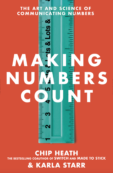Sign spotted today: “YES, we have patchouli.”
Obama and the missing slogan
Jacob Weisberg thinks Obama needs a good catchphrase for his economic plan:
If you go to the economy section on Obama’s Web site, the banner that greets you proclaims, “Responsible Tax Cuts for Ordinary Americans.” It’s accompanied by an image of two piggy banks, a small one labeled “Taxes” and a big one labeled “Savings.” The fat piggie is overflowing with pennies. What, exactly, is the concept here? That we should save less to feed the tax piglet?
You’ve got to know when to Fuld ’em
Nicholas Kristof has a sticky piece today on the grotesque overpayment of CEOs who fail. Case in point: Richard Fuld, chief of the now-flushed Lehman Brothers, made a half-bil between 1993 and 2007. Good investment.
This story, and others like it, run the board on the traits of a sticky idea: They’re simple (Too much money!). Unexpected ($17,000 an hour!). Concrete ($6,000 shower curtains). Credible (the amounts are indisputable). Emotional (Outrage, envy, disgust). Story (Pick your CEO). And yet the public outcry never builds up to a roar. Only a half-hearted squawk.
I can’t explain it. Maybe people feel powerless to affect it. I.e., if you were really angry, to your core, about CEO pay, what would you do next? At least with global warming, you can switch out a lightbulb. But sadly, there’s no incremental action with CEOs — you can’t take a dollar out of Fuld’s pocket. (Even if you did, it wouldn’t be worth his time to retrieve it, because in the next 10 seconds, he’d have made another $47.)
Hands-only CPR
Chip and I were thrilled to work with the AHA on their new campaign promoting “Hands-only CPR.” (Our role was limited: We led a workshop early in the process as the AHA team contemplated how to talk about the new technique. But we had nothing to do with the ingenious commercials that Jerry Potts and his team have created.)
So here’s the simple idea: You can save a life just by pumping on someone’s chest. Mouth-to-mouth isn’t necessary. So if an adult collapses, call 911 and pump hard and fast on their chest until help arrives. (In a wonderful karmic coincidence, the correct pumping rhythm is about the same as the beat to the song “Stayin’ Alive.”)
The best sign that this idea has stuck is that SNL has already parodied it.
Add’l info: Our recent Fast Company column, which links the AHA campaign to some more general thoughts on how to explain new innovations.
Outstuck
Reader Greg Miller has made one of our book concepts stickier. Here’s the relevant passage of our book and then Miller’s improvement…
Another way to bring statistics to life is to contextualize them in terms that are more human, more everyday. As a scientific example, contrast the following two statements:
- Scientists recently computed an important physical constraint to an extraordinary accuracy. To put the accuracy in perspective, imagine throwing a rock from the sun to the earth and hitting the target within 1/3 of a mile of dead center.
- Scientists recently computed an important physical constraint to an extraordinary accuracy. To put the accuracy in perspective, imagine throwing a rock from New York to Los Angeles and hitting the target within 2/3 of an inch of dead center.
Which seems more accurate?
As you may have guessed, the accuracy levels in both questions are exactly the same, but when different groups evaluated the two statements, 58% of respondents ranked the statistic about the sun to the earth as “very impressive.” That jumped to 83% for the statistic about New York to Los Angeles. We have no human experience, no intuition, about the distance between the sun and the earth. The distance from New York to Los Angeles is much more tangible. (Though, frankly, the distance is still far from tangible. The problem is that if you make the distance more tangible—like a football field—then the accuracy becomes intangible. “Throwing a rock the distance of a football field to an accuracy of 3.4 microns” doesn’t help.)
Miller says: “I’ll offer this suggestion for improving the analogy of throwing the rock from New York to Los Angeles and hitting within 2/3 inch of dead-center. Units of distance are still too abstract. Better to say throwing a rock from New York to Los Angeles and hitting a 50-cent piece (which has a radius of about 2/3 inches.)”
Great point, Greg — thanks for making us more concrete!



